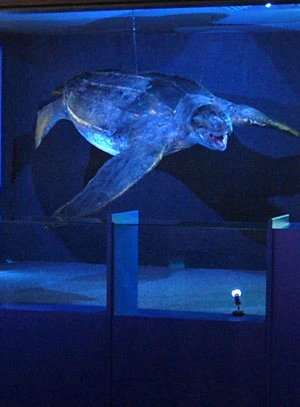The largest turtle in the world
The leatherback turtle on display at National Museum Cardiff was washed ashore on Harlech beach, Gwynedd in September 1988. Sadly, the turtle had drowned after being trapped by fishing lines. It was approximately 100 years old when it died. The turtle attracted worldwide attention as it was the largest and heaviest turtle ever recorded, measuring almost 3m (9ft) in length and weighing 914 kilos (2,016 pounds).
The turtle's arrival on the beach saw a flurry of activity by Museum staff who were keen to exhibit the turtle. However, preparing such a specimen for display was not straightforward.
The turtle had to be flipped upside down before repairing cracks on the underside.
Displaying the world's largest turtle
After undergoing an autopsy for scientific information, the skin was removed and preserved and a mould of the body shape was made. The preserved skin was stretched over the mould to produce a lifelike pose.
The skeleton was also removed and prepared for display alongside the body. The taxidermy mount and associated skeleton were then put on display in their own gallery, with linking displays on the leatherback's history, threats, ecology and conservation.
The Leatherback being cleaned and repaired
Sixteen years on
After 16 years on display, significant cracks had started to appear on the specimen. There had long been problems with cracking, and it had been patched up over the years. Low humidity was identified as a cause, so there was no choice but to close the gallery and conserve this popular specimen properly.
The first stage was to clean the turtle of its layer of dust and oily grime. A non-ionic detergent removed the worst of the dirt.
Once reasonably clean the next stage was to return the distorted parts of the specimen back to the correct shape. This involved soaking the exterior with a solution of deionised water, salt and detergent, enabling it to be moved back into position.
Removing old repairs
Once the specimen was dry, the old repairs were removed. This was a long and slow process requiring care so as not to damage the turtle's skin any further. A large amount of the skin had been painted black some years before, so this also had to be removed. This was achieved with acetone and a mobile fume extraction system.
Once the previous repairs and paint were removed, the turtle's original patterns and skin texture could be seen once more. Gaps and splits in the specimen were then filled in and painted over to blend with the turtle's original skin colour and texture.
The Turtle after conservation
The leatherback turtle in its new display at the National Museum, Cardiff
Redisplaying
The skeleton was also carefully cleaned before the finished turtle was re-hung as before. After 4 months of work, the turtle gallery could finally be re-opened to the public.
Another journey for the turtle
Conditions in the turtle gallery were continuing to cause conservation problems. As a result, during 2006 the turtle was moved to a new location in the adjoining 'Man and the Environment' gallery, next to the humpbacked whale. The new space has better environmental conditions, allowing the turtle to remain on open display. In addition, the information panels have been renewed with up-to-date information. The turtle now sits as a fine addition to this gallery space.

Comments - (33)
in 1971 a 7 foot sea turtle came within a few feet
Of our boat. I wish we had a camera as that was a giant turtle and beautiful sea creature